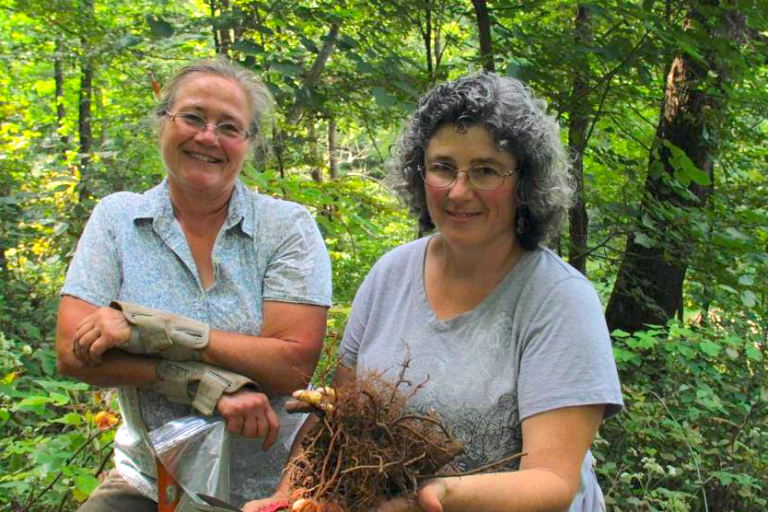- Agroforestry is set to expand in the eastern U.S. region of Appalachia with the announcement of new funding from the U.S. government.
- More than $590,000 will help growers increase production of a range of non-timber products like ginseng, which prefer to grow under forest cover.
- Growing crops in combination with woody plants like trees and shrubs in a system mimicking a forest is called agroforestry.
- Agroforestry is a highly climate- and biodiversity-positive form of agriculture that is estimated to sequester 45 gigatons of carbon from the atmosphere.
Appalachia is home to some of the most biodiverse temperate forests in the world, and it has a deep history of harvesting species like American ginseng for personal use and for sale. Now, agroforestry is set to expand the range and abundance of these non-timber forest products (NTFPs), thanks to new funding from the U.S. government.
Last month, U.S. Senators Mark Warner and Tim Kaine announced $593,056 in new federal funding for a university-led project that increases opportunities and skills of the region’s “forest farmers” who practice agroforestry, the intentional growing of crops like herbs and vegetables under a forest canopy that provides shade and microhabitats that favor growth of plants like ginseng, which has great medicinal value.
The funding will continue federal support of the Appalachian Beginning Forest Farmer Coalition (ABFFC), which is based at Virginia Tech and was initiated in 2015. The project receives funding from a variety of sources in addition to the federal government, and which to date totals $1.5 million including the latest grant via a program of the United States Department of Agriculture.
“I know the importance of forest farming for both our economy and our ecosystems. That’s why I was glad to have been able to help secure this funding, which will foster leadership and further strengthen our forest farming industry,” said Virginia Senator Warner in the announcement’s official statement.

Virginia Tech’s John Munsell directs the ABFFC and says the latest round of funding will support the next three years of their work. An associate professor and forest management extension specialist in the university’s Department of Forest Resources and Environmental Conservation, Munsell stressed to Mongabay the historic appropriateness of this project for the region.
“Approximately half of the woodland botanical species that supply the global nutraceutical industry are native to Appalachia,” he said. These include American ginseng (Panax quinquefolius), black cohosh (Actaea racemosa), goldenseal (Hydrastis canadensis), and bloodroot (Sanguinaria canadensis) among others.
“There also are scores [of] edible and decorative forest plants and fungi that have long-standing markets,” Munsell said. “The cultural and historical connections to these non-timber species, which have long been harvested in the wild, are rich but price points have historically been low. Forest farming provides a way for Appalachia’s forest-dependent and economically-distressed communities to produce traceable raw material.
“This improves price points for local producers because it allows environmentally- and socially-responsible companies to invest in, and confidently sell, to discerning consumers who care about and seek [to] support the people and places tied to the products they purchase,” Munsell added.
The ABFFC will funnel the bulk of the new funding to partner organizations, mainly nonprofits throughout the region that provide technical training, education, and outreach about forest farming in their various localities.

The effect of this agroforestry project goes far beyond local economic and conservation benefits for landowners and communities, however, firstly in terms of the carbon sequestration and biodiversity benefits of keeping forest cover intact, but also in terms of national awareness of agroforestry’s many benefits, says Susan Stein, the director of the U.S. Forest Service’s National Agroforestry Center (NAC).
“As interest and engagement in forest farming expands nationally, the ABFFC presents an inspiring example of how local communities and non-profit organizations, as well as state, federal, and private entities, are working together to make a difference through agroforestry,” Stein told Mongabay of the funding news.
This increasing interest in the U.S. adds to much greater global awareness and implementation of agroforestry. In May this year, more than 1,400 global delegates attended the World Agroforestry Congress in France, and in September, the world’s largest investment in agroforestry, an $85 million project in Africa, was announced.
These are just the most recent developments, however; agroforestry is an ancient technology developed over millennia by indigenous peoples, who are still its foremost practitioners. This climate- and biodiversity-positive form of agriculture is now said to cover up to a billion hectares (2.5 billion acres) of land globally — an area the size of Canada — and sequester more than 45 gigatons of carbon from the atmosphere, a figure that grows annually.
Back in the United States, the annual market value for crops like ginseng and goldenseal for herbal supplements and similar products was estimated to exceed $1 billion in 2013, a number which is rising as consumers seek out more natural remedies. Munsell and his colleagues therefore welcome the timing of the new ABFFC funding, as they plan to provide new and expanded farmer training.

“This is critical for the future of forest farming in Appalachia and beyond because demand for raw material is outpacing supply in certain product lines,” he said. “Increasing capacity is therefore essential, and the coalition aims to do just that with an eye toward balancing economic and environmental benefits. Also key will be the continuation of efforts to strengthen and expand profitable supply chains, and ultimately create a professional association that will provide a unified platform for forest farmers and stakeholders to learn, grow, and advocate for this agroforestry practice,” Munsell said.
There are more than 1,000 ABFFC members, 650 of whom self-identify as forest farmers. The membership also includes agency, industry, university, and extension personnel, and ABFFC members have participated in 25 technical training programs provided in states ranging from North Carolina to New York.
This report is part of Mongabay’s ongoing coverage of trends in global agroforestry, view the full series here.